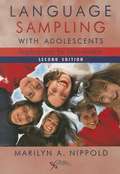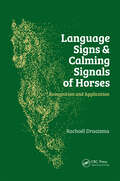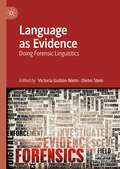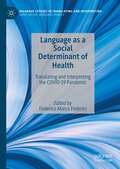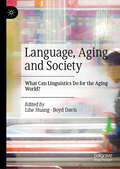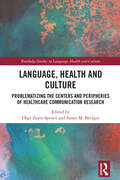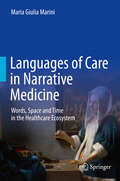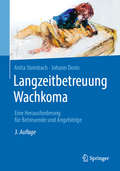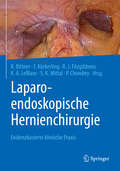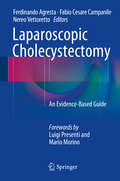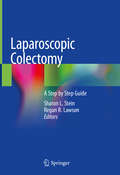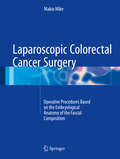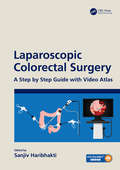- Table View
- List View
Language Sampling with Adolescents: Implications for Intervention (Second Edition)
by Marilyn A. Nippold<p>Language Sampling with Adolescents: Implications for Intervention, now in its second edition, provides guidelines for analyzing spoken and written language production in adolescents. It is geared toward graduate students and speech-language pathologists who work in the public schools with middle school and high school students (Grades 5-12). The book includes many tables, figures, and practical exercises (with answer keys) to help readers understand how to analyze the content and structure of what adolescents express in different genres: conversational, narrative, expository, and persuasive. Based on formal analyses, the book indicates how the information can be applied to establish functional language goals for adolescents with language disorders. It also explains how to implement intervention activities that are designed to enhance spoken and written language production in adolescents. <p>For the second edition, the author has revised and updated the content and added a new chapter on "Adolescent Language Disorders" that includes information on specific language impairment, nonspecific language impairment, and autism spectrum disorder. </p>
Language Signs and Calming Signals of Horses: Recognition and Application
by Rachaël DraaismaThis practical book helps you interpret and connect the physical signals that horses display in response to their environment. These signals are evident in the everyday actions, gestures and attitudes that horses communicate to each other, but are often so subtle that they can go unnoticed by humans. This book aims to rectify that, offering horse lovers and equine professionals an opportunity to gain a unique insight into their 'horse's world'.Key features:includes detailed description of language signs of domestic horses, with a special emphasis on calming signalsincludes 275 pictures to visualize various language signs, calming signals, behaviour sequences and facial featurespresents communication ladders to show how a horse responds to incentives in his environment, and what signals he uses at certain momentscontains tips on the use of the communication ladders and calming signals to improve the socialisation, training and wellbeing of your horseconsiders equine psychological stress from an environmental perspective, providing a valuable alternative to the current common clinical perspective.After reading this book you will be more astute in spotting calming signals, displacement activities, stress signals and distance-increasing signals, and better able to see which stimuli your horse can handle and which he cannot. This means you will know what to do to calm your horse before his stress rises to an unmanageable level. Language Signs and Calming Signals of Horses is both fascinating and important reading for any equine veterinary practitioner, student or nurse, as well as horse owners and trainers.
Language and Clinical Communication: This Bright Babylon
by John Skelton Dominic GreenyerThe search for a set of skills which can be identified and taught as 'good clinical communication' has been of considerable value in persuading decision makers at medical schools and other bodies that communication matters. These days, very large numbers of medical schools use what are essentially skills-based models, such as the extraordinarily thorough Calgary-Cambridge approach. However, I believe that the emphasis on communication' as simply a set of skills, such as eye contact, open questions and so on, has badly skewed the development of the discipline. The teaching of "communication skills" in fact strikes me as a very small part of what I do, not a very difficult part for the majority of students, and - whisper it - one which is often pretty dull...In "Language and Clinical Communication", John Skelton critically considers the theory behind this complex field. His wide-ranging approach reflects on the recent developments within the medical humanities and reflects on his controversial stance; questioning the relevance of skill-based teaching in the clinical arena in an accessible, easy to read manner. You will find Skelton's light-hearted and open-minded attitude to the topic unquestionably illuminating.
Language and Thought of the Child: Selected Works vol 5 (Routledge Classics Ser.)
by Jean PiagetJean Piaget was one of the most salient and inspirational figures in psychological and educational research of the 20th century. He was also prolific, authoring or editing over 80 books and numerous journals and papers which spawned a continuation of his work over the following decades. His work now compromises a major component of many courses on children's psychological development and in a research tradition which is expanding, scholars may need access to the original texts rather than secondhand accounts. This volume is the sixth of nine reproducing Piaget's original works - they are also available as a boxed set.
Language as Evidence: Doing Forensic Linguistics
by Dieter Stein Victoria Guillén-NietoThis edited book provides a comprehensive survey of the modern state of the art in forensic linguistics. Part I of the book focuses on the role of the linguist as an expert witness in common law and civil law jurisdictions, the relation of expert witnesses and lawyers, ethics standards, and courtroom interaction. Part II deals with some of the major areas of expertise of forensic linguistics as the scientific study of language as evidence, namely authorship identification, speaker identification, text authentication, deception and lie detection, plagiarism detection, and cyber language crimes. This book is intended to be used as a reference for academics, students and practitioners of Linguistics, Forensic Linguistics, Law, Criminology, and Forensic Psychology, among other disciplines.
Language as a Social Determinant of Health: Translating and Interpreting the COVID-19 Pandemic (Palgrave Studies in Translating and Interpreting)
by Federico Marco FedericiThis edited volume demonstrates the fundamental role translation and interpreting play in multilingual crises. During the COVID-19 pandemic, limited language proficiency of the main language(s) in which information is disseminated exposed people to additional risks, and the contributors analyse risk communication plans and strategies used throughout the world to communicate measures through translation and interpreting. They show that a political willingness to understand the role of language in public health could lead local and national measures to success, sampling approaches from across four continents. The book will be of interest to students and scholars of healthcare translation and interpreting, sociolinguistics and crisis communication, as well as practitioners of risk and crisis communication and professional translators and interpreters.
Language, Aging and Society: What Can Linguistics Do for the Aging World?
by Lihe Huang Boyd DavisThis book explores how studies of language and aging can be applied to build an aging-friendly society, drawing on the socio-pragmatic turn in language and aging to examine the perspectives of older adults experiencing aging through a linguistic lens. Research on the phenomenon and mechanisms of language in aging can provide older adults with language training, increase their active aging, and offer improved information communication channels for an aging society, which will bring a series of clinical and social benefits to handle problems in aging and language across the world. This book will be of interest to researchers in linguistics, sociology, gerontology and related fields.
Language, Dementia and Meaning Making: Navigating Challenges of Cognition and Face in Everyday Life
by Heidi E. HamiltonThis book investigates the ways in which context shapes how cognitive challenges and strengths are navigated and how these actions impact the self-esteem of individuals with dementia and their conversational partners. The author examines both the language used and face maintenance in everyday social interaction through the lens of epistemic discourse analysis. In doing so, this work reveals how changes in cognition may impact the faces of these individuals, leading some to feel ashamed, anxious, or angry, others to feel patronized, infantilized, or overly dependent, and still others to feel threatened in both ways. It further examines how discursive choices made by healthy interactional partners can minimize or exacerbate these feelings. This path-breaking work will provide important insights for students and scholars of sociolinguistics, applied linguistics, medical anthropology, and health communication.
Language, Health and Culture: Problematizing the Centers and Peripheries of Healthcare Communication Research (Routledge Studies in Language, Health and Culture)
by Susan M. Bridges Olga Zayts-SpenceLanguage, Health and Culture brings together contributions by linguistic scholars working in the area of health communication in Asia—in particular, in Hong Kong, Mainland China, Singapore, Japan and Taiwan. Olga Zayts-Spence and Susan M. Bridges, along with the contributors, draw on a diverse range of authentic data from different (primary, secondary, digital) healthcare contexts across Asia. The contributions probe empirical analyses and meta-reflections on the empirical, epistemological and theoretical foundations of doing research on language and health communication in Asia. While many of the medical and technological advances originate from the ‘non-English-dominant’/‘peripheral’ contexts, when it comes to health communication, there is a strong tendency to downplay and marginalize the scope and the impact of the ripe research tradition in these contexts. The contributions to the edited volume problematize the hegemony of dominant (Anglocentric) traditions in health communication research by highlighting culture- and context-specific ways of interpreting different health realities through linguistic lenses.
Language, Music and Gesture: LMGIC 2021
by Polina Eismont Tatiana Chernigovskaya Tatiana PetrovaThis book brings together selected revised papers representing a multidisciplinary approach to language, music, and gesture, as well as their interaction. Among the number of multidisciplinary and comparative studies of the structure and organization of language and music, the presented book broadens the scope with the inclusion of gesture problems in the analyzed spectrum. A unique feature of the presented collection is that the papers, compiled in one volume, allow readers to see similarities and differences in gesture as an element of non-verbal communication and gesture as the main element of dance. In addition to enhancing the analysis, the data on the perception and comprehension of speech, music, and dance in regard to both their functioning in a natural situation and their reflection in various forms of performing arts makes this collection extremely useful for those who are interested in human cognitive abilities and performing skills. The book begins with a philosophical overview of recent neurophysiological studies reflecting the complexity of higher cognitive functions, which references the idea of the baroque style in art being neither linear nor stable. The following papers are allocated into 5 sections. The papers of the section “Language-Music-Gesture As Semiotic Systems” discuss the issues of symbolic and semiotic aspects of language, music, and gesture, including from the perspective of their notation. This is followed by the issues of "Language-Music-Gesture Onstage" and interaction within the idea of the "World as a Text." The papers of “Teaching Language and Music” present new teaching methods that take into account the interaction of all the cognitive systems examined. The papers of the last two sections focus on issues related primarily to language: The section "Verbalization Of Music And Gesture" considers the problem of describing musical text and non-verbal behavior with language, and papers in the final section "Emotions In Linguistics And Ai-Communication Systems” analyze the ways of expressing emotions in speech and the problems of organizing emotional communication with computer agents.
Languages of Care in Narrative Medicine: Words, Space and Time in the Healthcare Ecosystem
by Maria Giulia MariniThis book explains how narrative medicine can improve evidence based medicine (EBM), making it more effective and efficient, giving patients better quality of life and offering more satisfaction to all health care providers. It discusses not only the disease experienced by the person who is ill, but also focuses on the context and the culture, and investigates how narrative medicine can make other disciplines around the globe more applicable, less manipulative, and more “scientific”. Only by integrating the narrative aspects, can EBM become more effective and efficient, with fewer uncured patients, more satisfied patients with a better quality of life, and satisfaction for all health care providers. Every chapter is divided into two main sections: the first presents the latest research in the field, with comments and interviews with experts, while the second section provides a list of practical exercises and tasks. The book is intended for anyone with an interest in caring for and curing patients: all care providers of care, physicians, general practitioners, specialists nurses, psychotherapists, counselors, social workers, providers of aid, healthcare managers, scientific societies, academics and researchers.
Languishing: How to Feel Alive Again in a World That Wears Us Down
by Corey Keyes&“With his pioneering research, Corey Keyes put languishing on the map. In this powerful book, he brings it to life. Get ready to rethink your understanding of mental health, update your views on happiness, and come closer to realizing your potential.&”—Adam Grant, #1 New York Times bestselling author of Hidden PotentialIf you&’re muddling through the day in a fog, often forgetting why you walked into a room . . . If you feel emotionally flattened, lacking the energy to socialize or feel joy in the small things . . . If you feel an inner void—like something is missing, but you aren&’t sure what . . . Then this book is for you.Languishing—the state of mental weariness that erodes our self-esteem, motivation, and sense of meaning—can be easy to brush off as the new normal, especially since indifference is one of its symptoms. It is not a synonym for depression and its attendant state of prolonged sadness. Languishers are more likely to feel out of control of their lives, uncertain about what they want from the future, and paralyzed when faced with decisions. Left unchecked, languishing not only impedes our daily functioning but is a gateway to serious mental illness and early mortality.Emory University sociologist Corey Keyes has spent his career studying the causes and costs of languishing—the neglected middle child of mental health. Now Keyes has written the first definitive book on the subject, examining the ripple effect of languishing on our lives before deftly diagnosing the larger forces behind its rise: the false promises of the self-help industrial complex, a global moment of intense fear and loss, and a failing healthcare system focused on treating rather than preventing illness.Ultimately, Keyes presents a counterintuitive approach to breaking the cycles keeping us stuck and finding a path to true flourishing. Unlike self-improvement systems offering quick-fix mood boosts, his framework focuses on functioning well: taking simple but powerful steps to hold our emotions loosely, becoming more accepting of ourselves and others, and carving out daily moments for the activities that create cycles of meaning, connection, and personal growth.Languishing is a must-read for anyone tempted to downplay feelings of demotivation and emptiness as they struggle to haul themselves through the day, and for those eager to build a higher tolerance for adversity and the pressures of modern life. We can expand our vocabulary for describing our inner experiences and deepest needs—and, with it, our potential to flourish.
Langzeitbetreuung Wachkoma: Eine Herausforderung für Betreuende und Angehörige
by Anita Steinbach Johann DonisDie Betreuung von Wachkoma-Patienten ist eine große Herausforderung für Pflegende, Therapeuten, Ärzte und Angehörige. In dem Band stellen die Autoren alle Aspekte zum Umgang mit Menschen im Wachkoma in den Kontext neuester Forschungsergebnisse: Grundhaltungen, medizinische Fragestellungen, Pflegemodelle und Qualitätsindikatoren müssen überdacht, neue ethische und gesundheitspolitische Fragestellungen beantwortet werden. Leicht verständlich geschrieben, ist der Band eine wertvolle Unterstützung für das gesamte Betreuungsteam und auch für Angehörige.
Langzeitresultate in der Extremitäten- und Wirbelsäulenchirurgie
by Hans-Kaspar Schwyzer Beat René Simmen Rainer-Peter MeyerIn diesem Buch präsentieren 38 renommierte Orthopäden 38 beeindruckende Langzeitverläufe in der operativen Orthopädie und Unfallchirurgie:· Das Nicht-Kennen-Wollen unserer Langzeitresultate ist wie das Verdrängen unseres eigenen beruflichen Werdeganges.· Aus der Langzeitdokumentation holen wir unsere Sicherheit, dem medizinisch-industriellen Komplex mit all seinen kurzlebigen technischen Neuerungen gegenüber kritisch zu sein.· Das Erarbeiten von Langzeitresultaten manifestiert die hohe Eigenverantwortung, die wir unseren Patienten gegenüber haben.Ein Plädoyer für mehr Engagement bei Archivierung und Analyse von Langzeitverläufen!
Lanthanide Luminescence
by Pekka Hänninen Harri HärmäLanthanides have fascinated scientists for more than two centuries now, and since efficient separation techniques were established roughly 50 years ago, they have increasingly found their way into industrial exploitation and our everyday lives. Numerous applications are based on their unique luminescent properties, which are highlighted in this volume. It presents established knowledge about the photophysical basics, relevant lanthanide probes or materials, and describes instrumentation-related aspects including chemical and physical sensors. The uses of lanthanides in bioanalysis and medicine are outlined, such as assays for in vitro diagnostics and research. All chapters were compiled by renowned scientists with a broad audience in mind, providing both beginners in the field and advanced researchers with comprehensive information on on the given subject.
Lanthanide-Doped Luminescent Nanomaterials
by Xueyuan Chen Yongsheng Liu Datao TuLanthanide-Doped Luminescent Nanomaterials reviews the latest advances in the development of lanthanide-doped luminescent inorganic nanoparticles for potential bioapplications. This book covers the chemical and physical fundamentals of these nanoparticles, such as the controlled synthesis methodology, surface modification chemistry, optical physics, and their promising applications in diverse bioassays, with an emphasis on heterogeneous and homogeneous in-vitro biodetection of tumor biomarkers. This book is intended for those readers who are interested in systematically understanding the materials design strategy, optical behavior of lanthanide ions, and practical bioapplications of lanthanide nanoparticles. It primarily focuses on the interdisciplinary frontiers in chemistry, physics and biological aspects of luminescent nanomaterials. All chapters were written by scientists active in this field and for a broad audience, providing both beginners and advanced researchers with comprehensive information on the subject. Xueyuan Chen is a Professor at Fujian Institute of Research on the Structure of Matter (FJIRSM), Chinese Academy of Sciences. Yongsheng Liu is a Research Associate Professor at FJIRSM, Chinese Academy of Sciences. Datao Tu is a Research Assistant Professor at FJIRSM, Chinese Academy of Sciences.
Laparo-endoscopic Hernia Surgery: Evidence Based Clinical Practice
by Karl A. LeBlanc Reinhard Bittner Ferdinand Köckerling Pradeep Chowbey Robert J. Fitzgibbons Jr. Sumeet K. MittalThis book is distinctive in that it focuses exclusively on current laparoscopic and endoscopic techniques for inguinal, primary and incisional abdominal wall, and hiatal hernias. Individual steps in diagnosis and treatment are described by experts in the field, but this clinical expertise is also integrated with the best available external evidence from systematic research as encapsulated in statements, recommendations, and guidelines. The reader will thus not only learn how to perform techniques systematically and reproducibly but also come to understand which of the procedures have been scientifically validated by studies, reviews, and meta-analyses and which have simply developed empirically. The descriptions of technique are supplemented by detailed guidance on such aspects as indications, anesthesia, aftercare and pain management, and the prevention and management of complications. Where appropriate, careful comparisons are made of competing repair options, including open techniques. In summary, this book will help practicing surgeons to standardize their operative technique so as to reflect current scientific knowledge and thereby improve the quality of laparoscopic/endoscopic hernia surgery.
Laparo-endoskopische Hernienchirurgie: Evidenzbasierte Klinische Praxis
by Karl A. LeBlanc Reinhard Bittner Ferdinand Köckerling Robert J. Fitzgibbons Sumeet Mittal Pradeep ChowbeyDiagnostik und laparoskopische Therapie von Leistenhernien, Bauchwand- und Narbenhernien sowie Hiatushernien werden Schritt für Schritt und mit zahlreichen Abbildungen von einem internationalen Expertenteam beschrieben. Neben den etablierten Verfahren sind auch neu entwickelte Operationstechniken und das Vorgehen bei atypischen und komplexen Hernienformen dargestellt, ebenso die Prävention und Behandlung von Komplikationen. Der Netztechnologie ist zu jedem der Hauptthemen ein eigenes Kapitel gewidmet. Vor- und Nachteile der einzelnen Behandlungsformen werden diskutiert und verglichen. Jedes Kapitel nimmt dabei Bezug auf die anerkannten Leitlinien der Fachgesellschaften und die relevanten Studien, Übersichten und Metaanalysen und bezieht zugleich die Erfahrungen und Empfehlungen renommierter Hernienchirurgen ein. Standardisierte Operationstechnik und evidenzbasierte Entscheidungsfindung tragen zur Verbesserung der Behandlungsergebnisse in der laparo-endoskopischen Hernienchirurgie bei.
Laparoscopic Anatomy of the Pelvic Floor
by Jean-Bernard Dubuisson Jean Dubuisson Juan PuigventosGynaecological surgery has made tremendous strides in the last 30 years, due to advances in medical imaging, operative laparoscopy, and new types of prosthesis. Reconstructive plastic surgery of pelvic organ prolapse and of urinary incontinence have benefited from these developments. The laparoscopic sacropopexy and laparoscopic lateral suspension with meshes are two excellent examples. In order to successfully perform these operations, detailed knowledge of the anatomy of the pelvic floor as “seen from above”, i.e., from the abdominal view, is an invaluable asset. Achieving perfect knowledge of the anatomical details is now possible, thanks to laparoscopy. With the aid of laparoscopy, following subperitoneal dissections, reconstructive surgery of the pelvic floor can be made substantially more precise, more exact, and also more anatomical. This atlas will allow gynaecologic surgeons to deepen and improve their anatomical expertise, with the aid of laparoscopy. It also describes in detail the most common laparoscopic operative techniques. The book represents a new and unique approach to anatomy studied in the living, and supplements the main content with a wealth of straightforward and clearly explained photographs.
Laparoscopic Antireflux Surgery
by Sungsoo Park Miguel Burch Joong-Min ParkThis book provides detailed, up-to-date information on gastroesophageal reflux disease (GERD) and all aspects of laparoscopic antireflux surgery. Clear descriptions of surgical techniques and important surgical tips are combined with state of the art research results to create a unique resource for general surgeons and other health care providers. The book opens by presenting the latest knowledge on the pathogenesis of GERD, identifying the target symptoms, and explaining diagnostic tests and their interpretation. The various techniques of fundoplication are then clearly described and illustrated, with provision of advice on the postoperative clinical pathway and the management of complications. Laparoscopic revision of failed antireflux surgery is fully covered, and the use of antireflux surgery in specific situations, such as achalasia and paraesophageal hernia, is discussed. The relationship between sleeve gastrectomy and GERD is also explored. Finally, guidance is provided on magnetic sphincter augmentation using the LINX Reflux Management System and on other emerging surgical options.
Laparoscopic Cholecystectomy
by Ferdinando Agresta Fabio Cesare Campanile Nereo VettorettoThis book, written by expert surgeons, offers a comprehensive and up-to-date overview of all aspects of laparoscopic cholecystectomy. Coverage includes the indications for surgery, anesthesia, surgical technique, and the prevention and management of complications, with extensive reference to the latest clinical evidence and assessment of the benefits of the laparoscopic approach, for example in terms of outcomes and day surgery. New technologies, including SILS, NOTES, robotic surgery, and miniaturized instruments, are reviewed. The learning curve and training are also extensively discussed, and an individual chapter is devoted to the views of international experts in the field. Readers will find the book to be an ideal guide to this gold standard technique, which continues to evolve some 20 years after the National Institutes of Health Consensus Conference first published recommendations regarding indications for laparoscopic cholecystectomy.
Laparoscopic Colectomy: A Step by Step Guide
by Sharon L. Stein Regan R. LawsonThis book is designed specifically to help equip new surgeons with the anatomical and technical knowledge to supplement hands on experience in minimally invasive colon and rectal surgery. There are multiple colorectal surgeries which distinctly lend themselves to the use of the laparoscopic approach. To assist the junior surgeon who is embarking on a career in surgery, expert surgeons and educators in the field of colon and rectal surgery from around the country authored the chapters included in this book. Chapters describe key elements of each surgery, including the order of surgery, when and how the surgeon created tension, rotated the patient, and optimized flow of the surgery. Chapters also contain tips and pitfalls that are not always explicitly presented when describing a surgical approach in order to provide readers with a diverse toolkit. Each chapter is also full of new illustrations that show the direction of traction, the line of dissection, and the anatomy of the colon. The illustrations also present tools in a color-coded format to clearly distinguish between the surgeon’s and the assistant’s tools. Laparoscopic Colectomy: A Step by Step Guide is a valuable resource to residents and junior attendings who wish to master laparoscopic colon and rectal surgery.
Laparoscopic Colon Surgery: Milestones, Education, & Best Practice
by Gregory Kouraklis Eugenia Jenny MatsiotaThis book is the structured, comprehensive work of experienced surgeons and constitutes the condensed and succinct epitome of knowledge and guidance for those interested in Laparoscopic Colon Surgery (LCS), focusing only on colon laparoscopy. The milestones in LCS are presented offering valuable background information about the evolution of LCS throughout the years and presenting how it still has a limited application, no matter the need for minimal invasive, fast-track, surgical procedures that can offer better quality to patients and less cost for any healthcare system. The book aims to highlight the preferred diagnostic procedures, the right methods for the efficient and rational selection of patients, the choice of the best surgical techniques and treatments, and the best management of post-operative complications for an early discharge. It provides adequate information to the surgeons or the surgical residents interested in LCS about how to select, what to avoid, what instruments to use, what techniques to follow, how the evaluation of patient’s anatomy can lead to better surgical planning, and the add-on of robotic colon surgery in the quality of patients’ life. Moreover, the book provides information about the most efficient anaesthesia adequate for LCS; information that most books of its kind do not include. Finally, the book provides excellent information about the best education and practices to be followed in LCS; something of special importance after considering the level of difficulty associated with LCS and the high conversion rate compared to other laparoscopic procedures. Although the primary focus of this book are surgeons (LCS, GI, General) and surgical residents, the content still can offer valuable information to these healthcare leaders who are interested in understanding the milestones and benefits of the right model of education, and the best practices related to LCS.
Laparoscopic Colorectal Cancer Surgery
by Makio MikeThis unique guide describes colorectal surgery procedures using medical terminology and anatomical terms originating from embryology. In the last decade, laparoscopic procedures in gastrointestinal surgery have been enhanced and their safety has significantly improved. With the number of cases of colorectal cancer surgery increasing and laparoscopic surgery no longer considered a specialized surgery, the recognition of the correct anatomy is vital in these procedures. Unfortunately, however, the understanding of clinical anatomy is frequently separate from that of basic surgical concepts. Initially, the dissecting layer should be presumed to derive from the fascial anatomy based on embryological recognition. Furthermore, the techniques currently being used by surgeons should be described in sufficient detail and the appropriate anatomical terms should always be used. In view of this, this valuable monograph benefits gastrointestinal surgeons and general surgeons who are involved in the treatment of colorectal cancer.
Laparoscopic Colorectal Surgery: A Step by Step Guide with Video Atlas
by Sanjiv HaribhaktiThis comprehensive book provides the reader a perspective of the current evidence-based management of Laparoscopic Colorectal Surgery. It covers sections on benign surgery for IBD, diverticulitis, rectal prolapse etc. along with the procedures for colon and rectal cancers, including laparoscopic TME. The accompanying videos complement the text imparting specific operative skills of exposure, retraction, countertraction, dissection, vascular control, hemostasis, laparoscopic Stapling, anastomosis, specimen extraction and stoma formation. This book aims to help surgeons to learn, standardize, practice and master the complex skills of Laparoscopic colorectal surgery. Key Features Provides step by step solution to the difficulties encountered by the beginners by covering a section on bugbears. Caters to General, GI, Oncology and Colorectal surgeons who have the adequate basic laparoscopic skills and have already been doing some advanced laparoscopic surgery in form of laparoscopic Upper GI and bowel surgery and would want to start laparoscopic colorectal surgery. Covers a section on Robotic and single incision laparoscopic surgery providing the contemporary knowledge in this emerging field, whereas a section on trans-anal surgery provides a futuristic dimension to this field.
